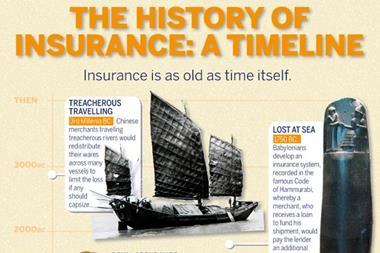The Cutty Sark fire has raised awareness of the problem of insuring historical property. Anita Anandarajah reports
The embers have cooled aboard the Cutty Sark but the flames are still flickering in the insurance world. What was the 138-year-old clipper valued at? How does one place a value on a one-of-a-kind historical ship?
The basis of insurance for historical buildings is not related to the market or sale value, but the cost of restoration and repairs.
Ian Wainwright, group chief surveyor at Ecclesiastical Insurance, which specialises in insuring churches and historical buildings, as well as the Royal Docks in Portsmouth, says: “If this were an historical building or a listed house, what you’d be valuing is the cost to replace it in a similar style using
similar materials to what was there before.”
Wainwright goes on to explain that the replacement value has to take into account the fact that the original materials used, if available, will be costly, as is the short supply of skilled tradesmen.
Martin Cardus, managing director of Towergate Underwriting Marine, pointed out the dilemma insurers face: the gap between the actual value of the vessel in its pre-restoration state and the value of the
finished article. “The cost of authentic
materials and highly skilled labour have to be factored in, but on what basis: market value, agreed value, reinstatement, cost of materials?”
Cardus says: “This situation highlights the multi-faceted risks involved when attempting to insure high profile national heritage restoration projects.
“How any project manager or the insurance adviser can establish a sum insured and basis of cover which identifies all possible financial and non-financial risks that may incur is the equivalent of searching for the Holy Grail.”
In a market eager to sell the product of the moment is business interruption (BI) losses.
As the Cutty Sark has been closed to the public since November 2006 while undergoing major restoration work, BI losses will not be immediate, says Keith Tuffin, partner at forensic accountants RGL.
“However, the project may be delayed unless work can be expedited, in which case there would be BI.”
A possible delay in the opening will result in the loss of income derived from receipts from corporate events and visits to the Cutty Sark. John Heany, specialist commercial underwriter at Hiscox drove the point home when he highlighted the growing interest in bookings for London venues from 2009 in the run-up to the 2012 Olympics.
Says Heany: “There will be a lot of activity around the East End and it may seem that the Cutty Sark stands to lose millions if we expect an additional 12 months to rebuild it.
“This is a classic
accumulation of
risk. The difficulty
lies in adequately
protecting such a riskMartin Cardus, Towergate
“The big issue is if you want to hold an event in a unique venue then cancellation cover becomes important. There is the cost of rental of the venue and lost income to consider.”
The 2005 Cutty Sark Trust annual report shows that the clipper generated £466,796 in admission charges (£498,918 in 2004). Sale of souvenirs brought in £154,666 (£148, 911) and function income (from services supplied to the company) amounted to £76,357 (£92,596).
Other parties who stand to lose from the delayed opening of the clipper will be businesses in the surrounding area that will lose out from tourist visits. Then there is also the question of whether the repaired Cutty Sark will be as interesting to visitors as so much history has been lost.
Public awareness
Tuffin says: “There is of course the fact that such a dramatic fire engulfed the Cutty Sark may promote public awareness and interest. It will be in the interest of all concerned that the Cutty Sark is restored to her former glory, both as a national tresure and financially, as soon as possible.”
The Cutty Sark fire highlights the vulnerability of high profile, high value projects in an easily accessible location.
Says Cardus: “This is a classic accumulation of risk. The difficulty lies in adequately protecting such a risk.
“Short of erecting a fully-fortified no-go compound with restricted access and employing full-time security guards it only takes one lunatic to damage a nation’s heritage. Totally secure dockyards are in short supply and movement of the vessel is out of the question. However, these options appear cost-effective in comparison to the repair bill now faced by the insurers.”
Borrowing from Ecclesiastical's past experience, Wainwright explains that when a historical structure is undergoing restoration, the risk of a fire happening increases; particularly with scaffolding, which makes it accessible to possible arsonists. There are materials lying around, like flammable
liquids and paper that can become ready-made bonfires.
Alex Hindson, associate director at Aon Global Risk Consulting, says one way for businesses to prevent such an incident from occurring is to control the unusual. “Try to identify what vulnerabilities exist, particularly when there is major refurbishment and construction taking place. There is no magic bullet. just careful management.”
At the time of writing, Royal & Sun Alliance (R&SA) still would not comment on the value of the policy or the size of the claim, except to reiterate its earlier comment that the insurer “did not expect to suffer a material financial setback”.
R&SA was awarded the contract to underwrite physical damage cover for the Cutty Sark renovation project in January, and is the principal insurer of the hull. The deal was brokered by Hayes Parsons Marine and Willis. R&SA have appointed Burgoynes as the loss adjuster.
The clipper was 100% insured but losses are said to be less serious as 50% of the parts, including the mast and spars, are being stored at Chatham dockyard. IT




































